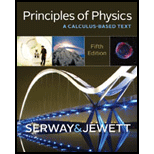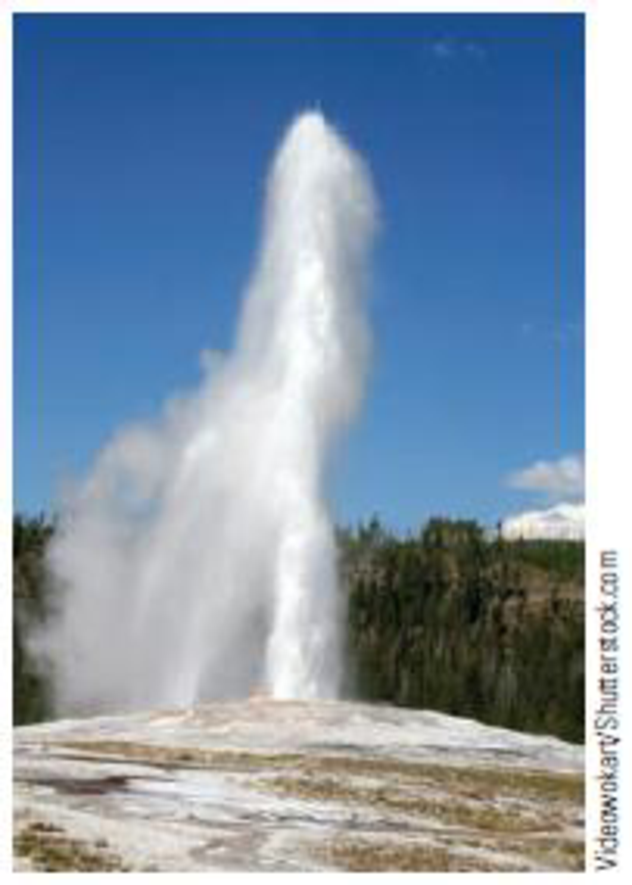
Concept explainers
Review. Old Faithful Geyser in Yellowstone National Park erupts at approximately one-hour intervals, and the height of the water column reaches 40.0 m (Fig. P15.40). (a) Model the rising stream as a series of separate droplets. Analyze the free-fall motion of one of the droplets to determine the speed at which the water leaves the ground. (b) What If? Model the rising stream as an ideal fluid in streamline flow. Use Bernoulli’s equation to determine the speed of the water as it leaves ground level. (c) How does the answer from part (a) compare with the answer from part (b)? (d) What is the pressure (above atmospheric) in the heated underground chamber if its depth is 175 m? Assume the chamber is large compared with the geyser’s vent.

Figure P15.40
(a)
The speed at which the water leaves the ground by modelling the stream as a series of separate droplets.
Answer to Problem 40P
The speed at which the water leaves the ground by modelling the stream as a series of separate droplets is
Explanation of Solution
Consider the upward flight of a water-drop projectile from geyser vent to fountain top.
Take the upward direction to be
Write the equation of motion in the vertical direction.
Here,
At the maximum height the velocity of the water drop will be zero so that the value of
Substitute
Conclusion:
The value of
Substitute
Therefore, the speed at which the water leaves the ground by modelling the stream as a series of separate droplets is
(b)
The speed of the water as it leaves the ground by modelling the stream as an ideal fluid in streamline flow.
Answer to Problem 40P
The speed of the water as it leaves the ground by modelling the stream as an ideal fluid in streamline flow is
Explanation of Solution
Write the Bernoulli’s equation.
Here,
Air has very low density so that the pressure at both geyser vent and fountain-top will be atmospheric pressure.
Substitute
Conclusion:
Substitute
Therefore, the speed of the water as it leaves the ground by modelling the stream as an ideal fluid in streamline flow is
(c)
The comparison of answers of part (a) and part (b).
Answer to Problem 40P
The answers of part (a) and part (b) agree precisely.
Explanation of Solution
It is asked to find the speed with which the water leaves the ground. In part (a), the rising stream was modelled as free-fall motion of one of the droplets. The value of the speed found using this model is
In part (b), the rising stream was modelled as an ideal fluid in streamline flow. The value of the speed found using this model is also
Conclusion:
Thus, the answers of part (a) and part (b) agree precisely.
(c)
The pressure in the heated underground chamber.
Answer to Problem 40P
The pressure in the heated underground chamber is
Explanation of Solution
Take point 1 in the Bernoulli’s equation to be the chamber and the point 2 to be fountain-top.
The velocity of the water drop at both the points are
Substitute
Conclusion:
The density of water is
Substitute
Therefore, the pressure in the heated underground chamber is
Want to see more full solutions like this?
Chapter 15 Solutions
Principles of Physics: A Calculus-Based Text
Additional Science Textbook Solutions
General, Organic, and Biological Chemistry: Structures of Life (5th Edition)
Human Biology: Concepts and Current Issues (8th Edition)
Fundamentals Of Thermodynamics
Chemistry & Chemical Reactivity
Organic Chemistry
- please help me solve this questions. show all calculations and a good graph too :)arrow_forwardWhat is the force (in N) on the 2.0 μC charge placed at the center of the square shown below? (Express your answer in vector form.) 5.0 με 4.0 με 2.0 με + 1.0 m 1.0 m -40 με 2.0 μCarrow_forwardWhat is the force (in N) on the 5.4 µC charge shown below? (Express your answer in vector form.) −3.1 µC5.4 µC9.2 µC6.4 µCarrow_forward
- An ideal gas in a sealed container starts out at a pressure of 8900 N/m2 and a volume of 5.7 m3. If the gas expands to a volume of 6.3 m3 while the pressure is held constant (still at 8900 N/m2), how much work is done by the gas? Give your answer as the number of Joules.arrow_forwardThe outside temperature is 25 °C. A heat engine operates in the environment (Tc = 25 °C) at 50% efficiency. How hot does it need to get the high temperature up to in Celsius?arrow_forwardGas is compressed in a cylinder creating 31 Joules of work on the gas during the isothermal process. How much heat flows from the gas into the cylinder in Joules?arrow_forward
- The heat engine gives 1100 Joules of energy of high temperature from the burning gasoline by exhausting 750 Joules to low-temperature . What is the efficiency of this heat engine in a percentage?arrow_forwardL₁ D₁ L₂ D2 Aluminum has a resistivity of p = 2.65 × 10 8 2. m. An aluminum wire is L = 2.00 m long and has a circular cross section that is not constant. The diameter of the wire is D₁ = 0.17 mm for a length of L₁ = 0.500 m and a diameter of D2 = 0.24 mm for the rest of the length. a) What is the resistance of this wire? R = Hint A potential difference of AV = 1.40 V is applied across the wire. b) What is the magnitude of the current density in the thin part of the wire? Hint J1 = c) What is the magnitude of the current density in the thick part of the wire? J₂ = d) What is the magnitude of the electric field in the thin part of the wire? E1 = Hint e) What is the magnitude of the electric field in the thick part of the wire? E2 =arrow_forwardplease helparrow_forward
 Physics for Scientists and Engineers: Foundations...PhysicsISBN:9781133939146Author:Katz, Debora M.Publisher:Cengage Learning
Physics for Scientists and Engineers: Foundations...PhysicsISBN:9781133939146Author:Katz, Debora M.Publisher:Cengage Learning College PhysicsPhysicsISBN:9781938168000Author:Paul Peter Urone, Roger HinrichsPublisher:OpenStax College
College PhysicsPhysicsISBN:9781938168000Author:Paul Peter Urone, Roger HinrichsPublisher:OpenStax College Physics for Scientists and EngineersPhysicsISBN:9781337553278Author:Raymond A. Serway, John W. JewettPublisher:Cengage Learning
Physics for Scientists and EngineersPhysicsISBN:9781337553278Author:Raymond A. Serway, John W. JewettPublisher:Cengage Learning Physics for Scientists and Engineers with Modern ...PhysicsISBN:9781337553292Author:Raymond A. Serway, John W. JewettPublisher:Cengage Learning
Physics for Scientists and Engineers with Modern ...PhysicsISBN:9781337553292Author:Raymond A. Serway, John W. JewettPublisher:Cengage Learning Principles of Physics: A Calculus-Based TextPhysicsISBN:9781133104261Author:Raymond A. Serway, John W. JewettPublisher:Cengage Learning
Principles of Physics: A Calculus-Based TextPhysicsISBN:9781133104261Author:Raymond A. Serway, John W. JewettPublisher:Cengage Learning Physics for Scientists and Engineers, Technology ...PhysicsISBN:9781305116399Author:Raymond A. Serway, John W. JewettPublisher:Cengage Learning
Physics for Scientists and Engineers, Technology ...PhysicsISBN:9781305116399Author:Raymond A. Serway, John W. JewettPublisher:Cengage Learning





